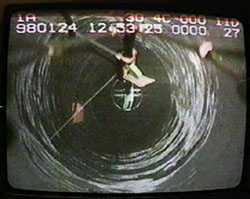
|

|
|
|
©
Per Olof Hulth
|
|
|
At
a depth of about 160 m, the walls become glossy and the
water is clearer.
|
|
|
|

A
literary essay about AMANDA by Francis Halzen
page 7
Once
in Antarctica, the operation is orchestrated by Bruce R. Koci,
our mechanical engineer and drillmeister. Much of the project
is entirely novel, making improvisation the rule, and Koci
is a genius at it. Early on, for instance, we found that our
hot-water drill was inadequate: it needed eleven days to drill
to a depth of 800 meters. So Koci and his colleagues designed
a new one. As sleek as a rocket, it dives into the ice gushing
190-degree water from its nose. In its first incarnation,
it traveled a thousand meters in four days. These days it
goes twice that fast. Mapping AMANDA’s geometry is like
manufacturing an optical telescope in a dark room. Yet Koci’s
drill, guided by gravity alone, deviates from the vertical
by less than a meter over a depth of two kilometers.
As the drill descends, it leaves a hole about fifty centimeters
in diameter, filled with hot water. (Because the hot water
is continuously circulated in the hole, and because the ice
around it acts like a giant thermos bottle, the water remains
liquid for a few days.) Once the drill is removed, the AMANDA
crew, often assisted by drillers and volunteers from other
scientific missions, attaches a 600-pound weight to a fiber-optic
master cable and then drops it into the hole. For the next
ten to twenty hours, photomultipliers are attached to the
sinking cable with carabiners of the kind used by rock climbers
and plugged in at predetermined positions like beads on a
rosary. Pressure and temperature meters, lasers, radio receivers,
pulsing or steady light-emitting devices and other devices
are also attached. (On one occasion a pair of television cameras
was sent into the hole; their images can be viewed on our
home page at <amanda.berkeley.edu>.)
THEN THE WAITING BEGINS. It takes three to four days for the
hole to refreeze completely. Just before the ice turns solid,
the pressure spikes dramatically—at a depth of a kilometer,
for instance, it rises suddenly from 100 to more than 500
atmospheres. So far, the crib death rate, when the holes refreeze,
has hovered around 2 percent. The survivors, encased within
their half-inch-thick glass spheres, should live forever—or
at least until I die.
As one of the superfluous theorists mentioned above, I have
never been invited to Antarctica. But even now, on the nights
when drilling goes on there, I can never sleep. To have your
career on the line half a world away is hard enough. But to
know that you have embroiled so many others in the same improbable
adventure, that your funders and colleagues expect results,
and that you are totally powerless to affect the outcome,
is a form of exquisite torture. And so I keep a laptop at
my bedside and check it all through the night for E-mail dispatches.
|
